Fork tender chunks of beef, cooked low and slow with a paprika sauce in this classic Hungarian beef paprikash. Finished with a bit of sour cream. Serve over egg noodles or mashed potatoes.
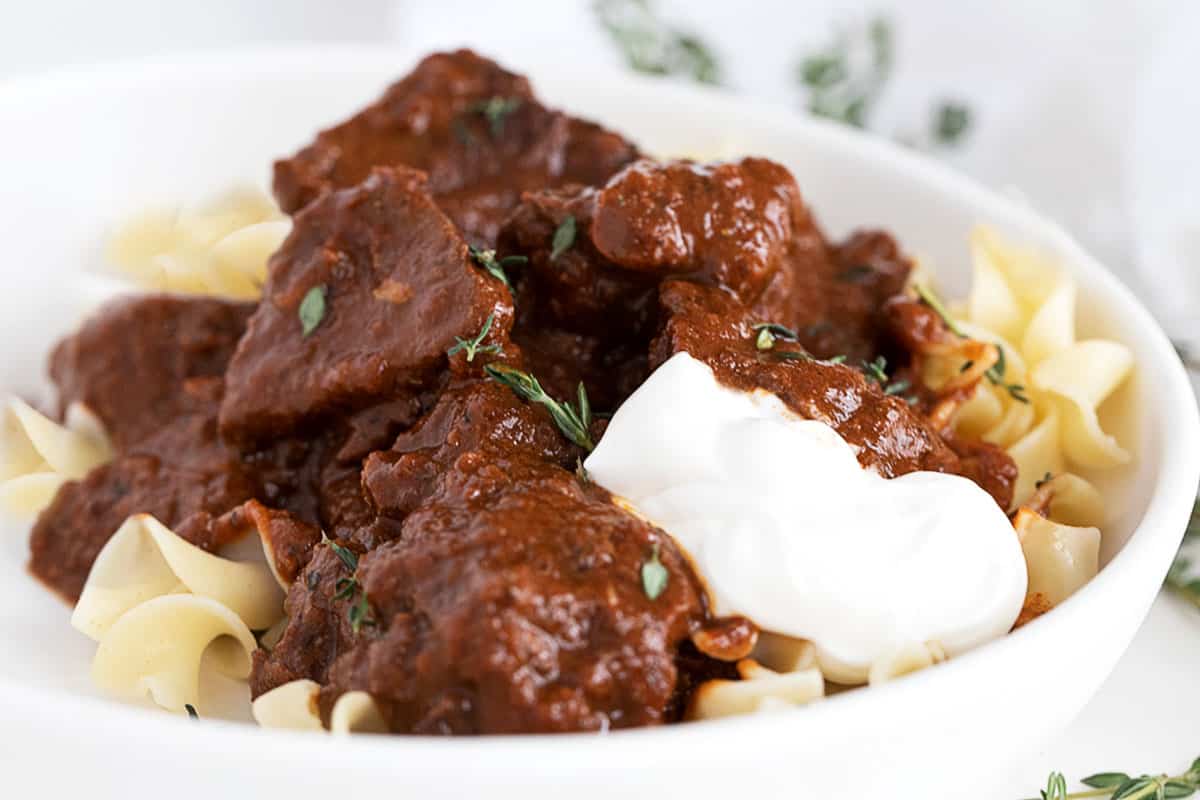
Why you’ll love this beef paprikash recipe
- You’ll love the fork-tender beef, combined with the classic Hungarian Paprika-flavoured sauce. Finished with sour cream, for a bit of tangy, creaminess. It’s classic comfort food!
- The low and slow cooking method makes the most of the economical cuts of beef, as the braising will make any cut tender.
- Beef Paprikash keeps well in the fridge (and just gets better with the rest) and also freezes well.
Ingredients and substitutions
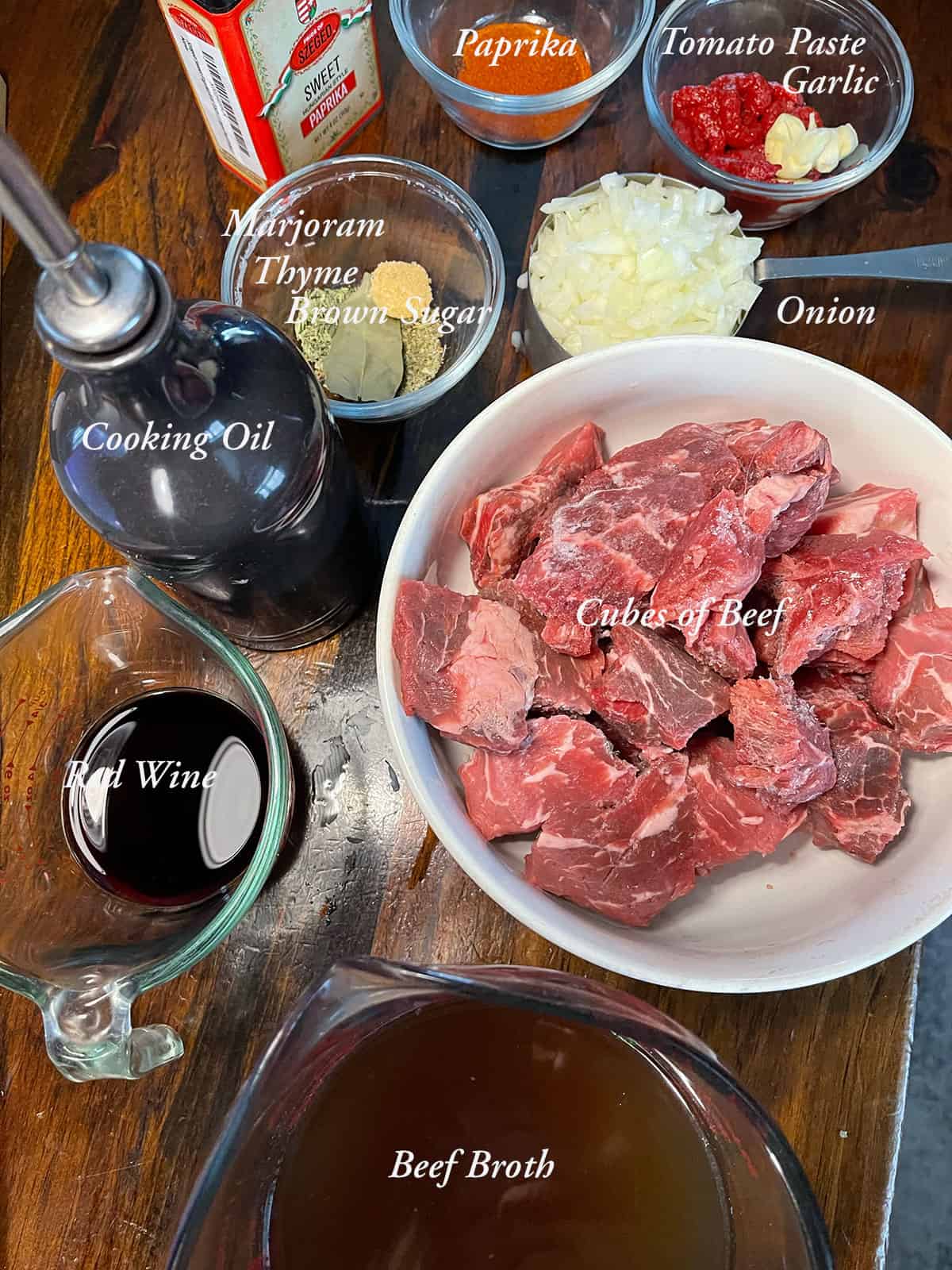
Beef – you can start with pre-cubed stewing beef or I will often just cube up a small roast instead. A blade (chuck) roast or a top round roast are probably the best choices, for the most tender results, but any beef roast will work here. Trim away and discard any large pieces of fat from the beef.
Red Wine – I can’t seem to make a dish like this without deglazing the pan with wine. Red wine is ideal, though white will also work. If you don’t have wine or prefer not to use it, you can deglaze the pan with a bit of water instead.
Paprika – if you have Hungarian paprika, that would obviously be the perfect choice for this dish. Otherwise, just use Spanish or regular paprika. I use sweet paprika, but you can add a pinch of hot paprika, if you like.
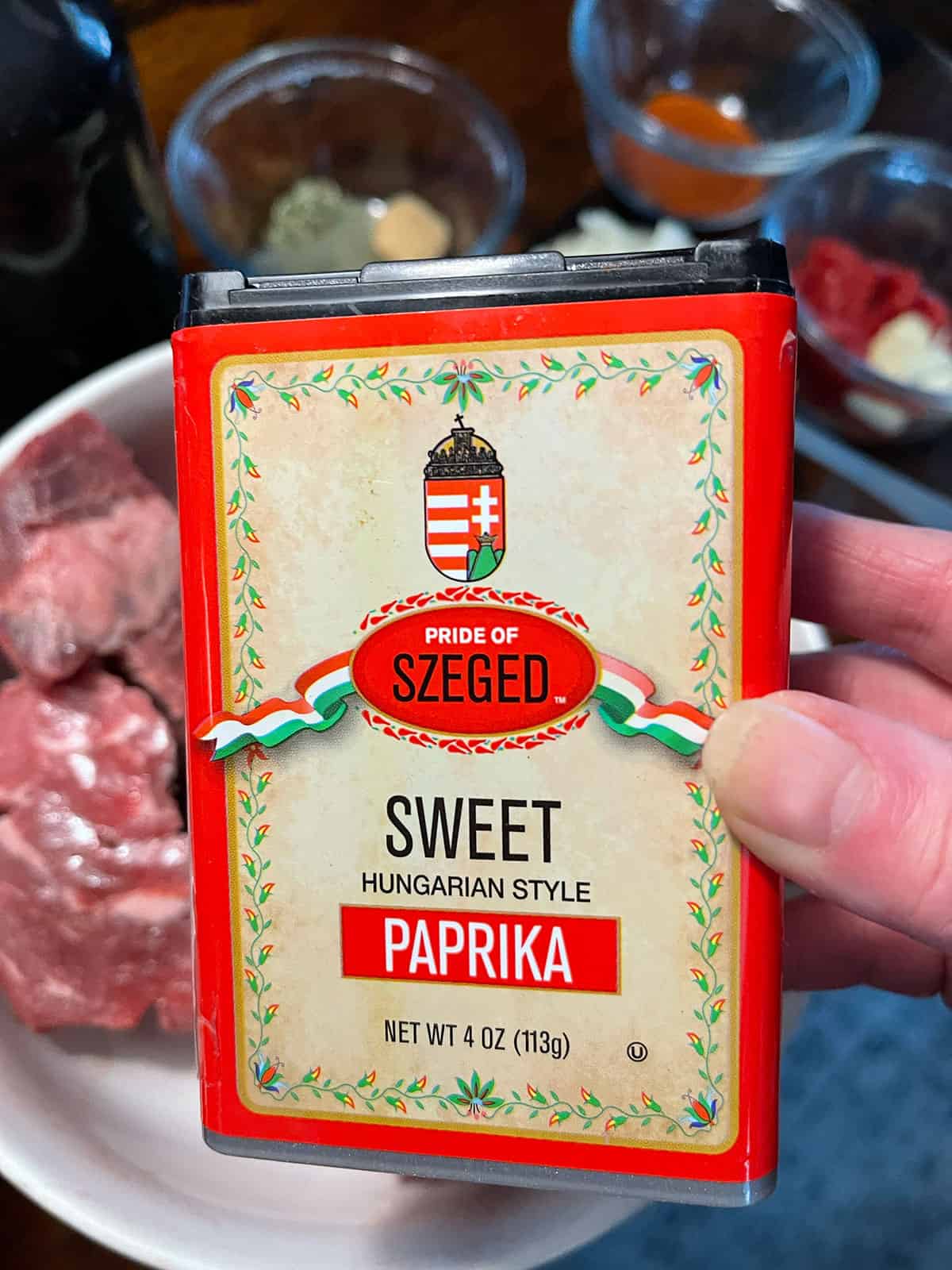
Caraway Seed – I am not a fan of Caraway, so I always skip it. If you like it and have it, certainly go ahead and add it. It is a very tough seed, so breaking it up with a mortar and pestle is a good idea.
Sour Cream – I stir a bit of sour cream in at the end, which is characteristic of a paprikash. You can certainly omit, if you prefer and enjoy this dish as a goulash.
How to make Beef Paprikash: Step-by-Step
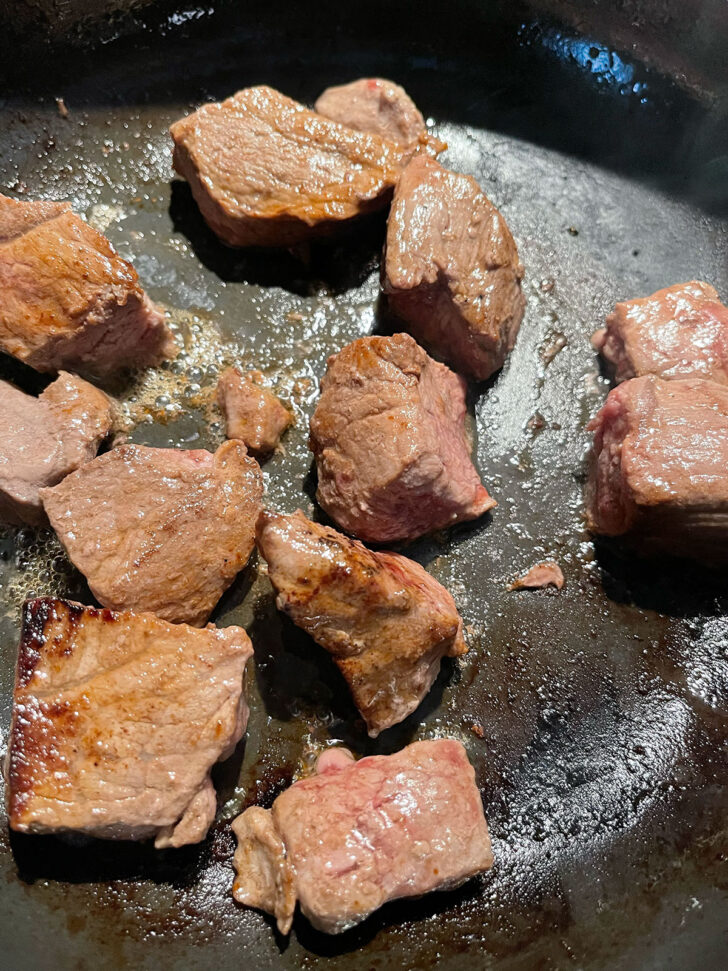
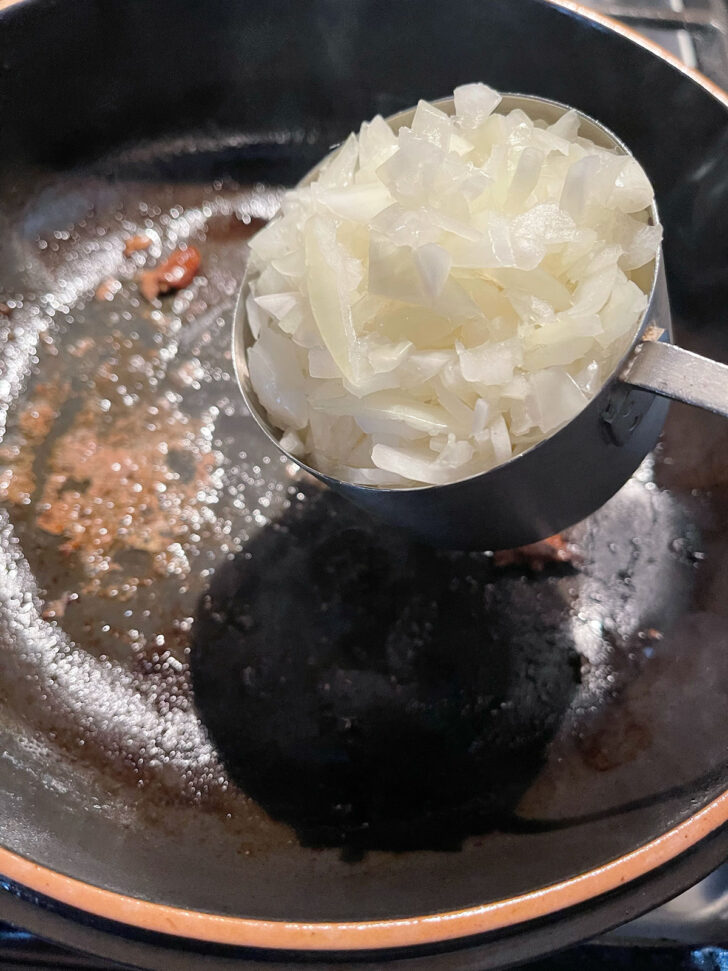
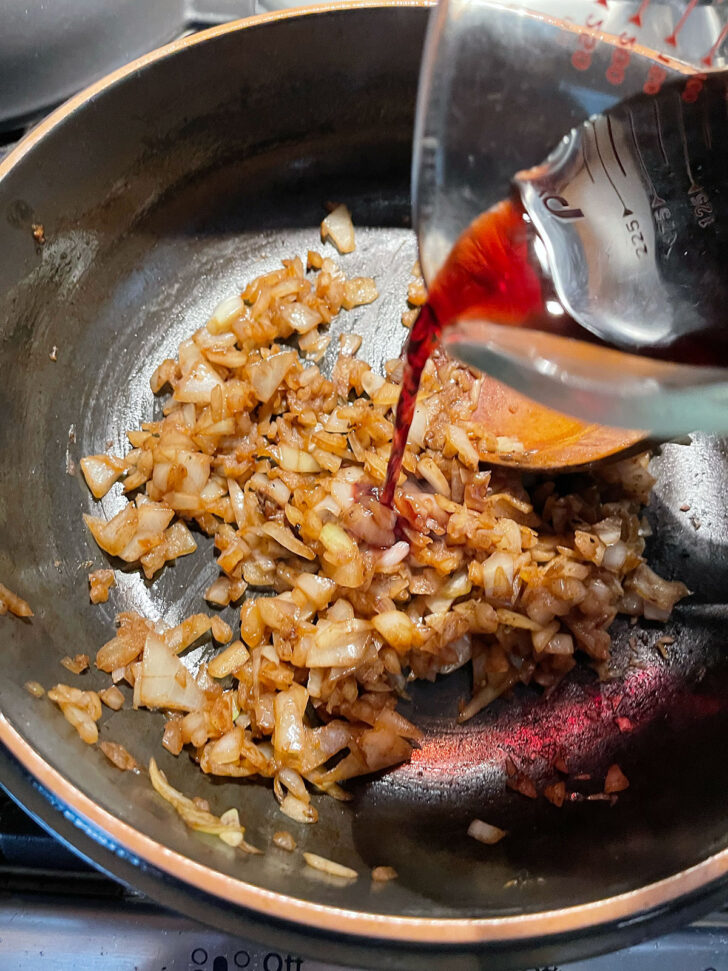
- Heat some oil in a heavy-bottomed pot over medium-high heat and brown the beef in batches. Be sure not to crowd the pan, as this will just make too much moisture that will steam the meat, rather than browning it. I like to do 3 batches, adding a bit more oil in between batches.
- Remove the beef to a bowl, then cook the onions until golden.
- Deglaze the pan with the wine (or water).
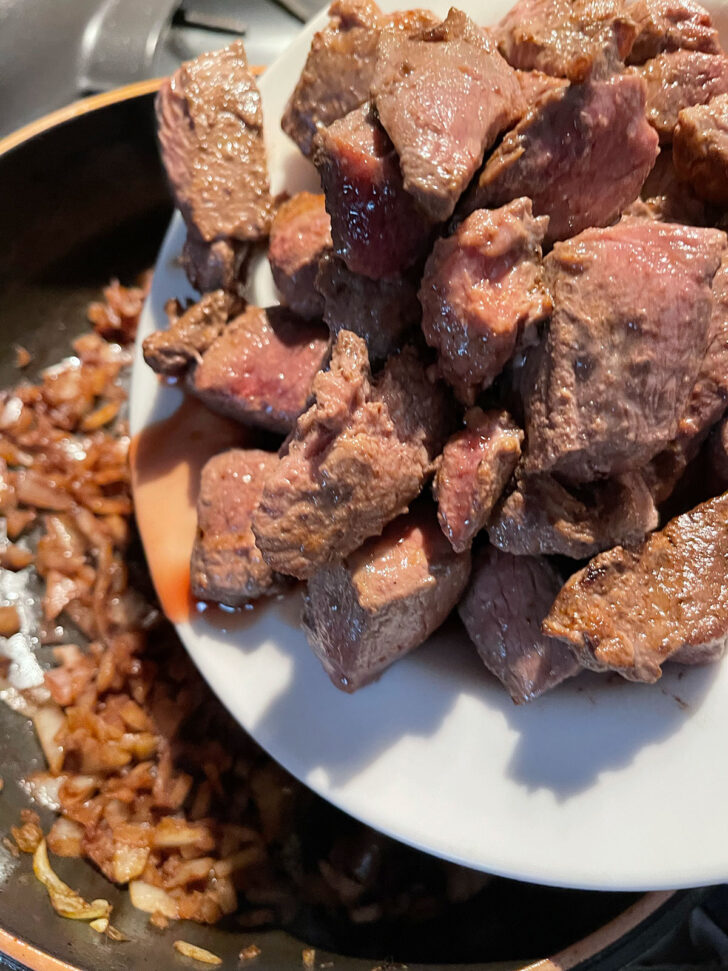
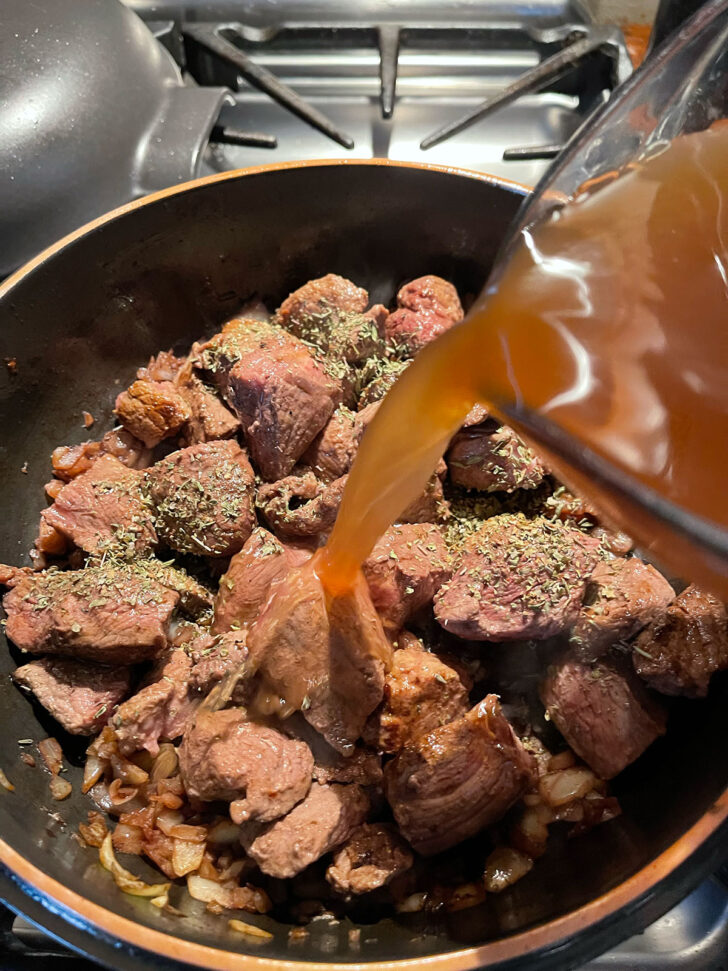
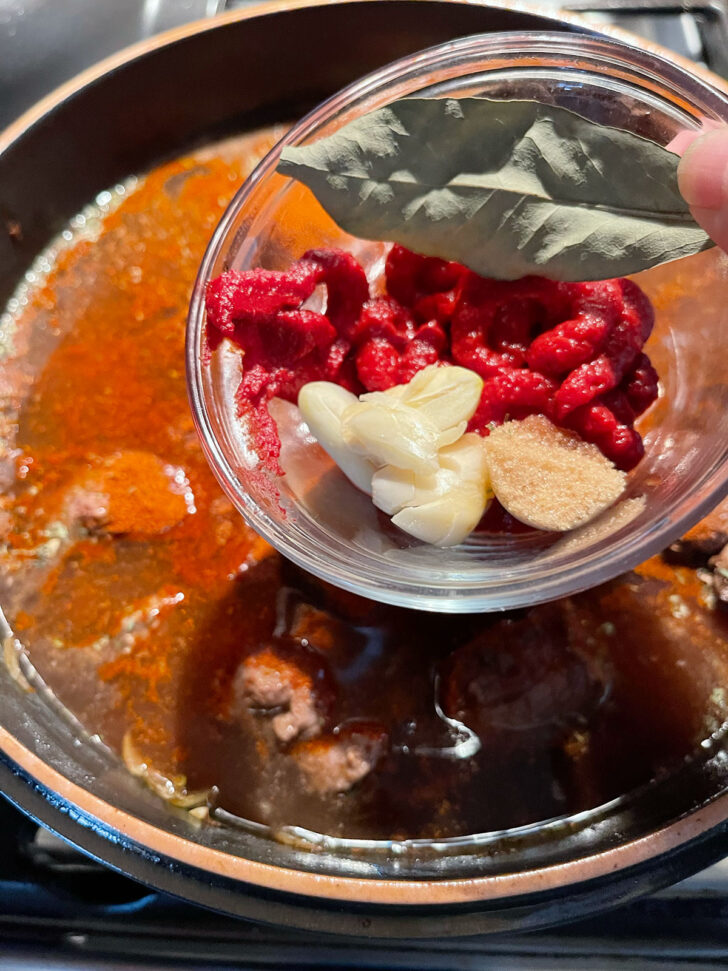
- Return the beef to the pan with the onions.
- Add the beef broth and dried spices.
- Add the tomato paste, garlic, brown sugar and a bay leaf to the pot.
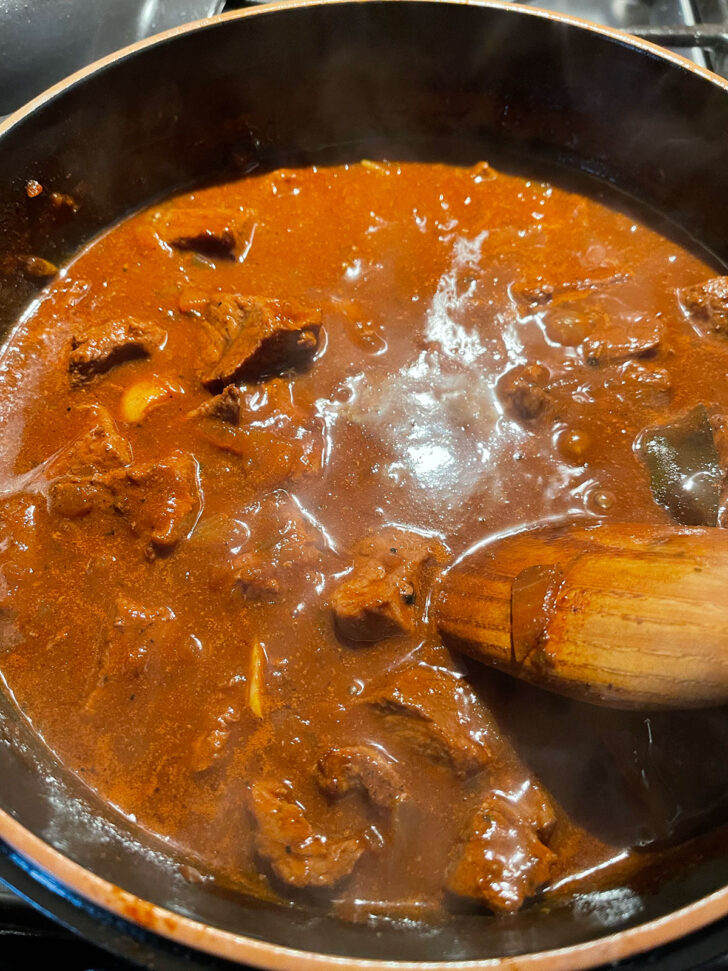
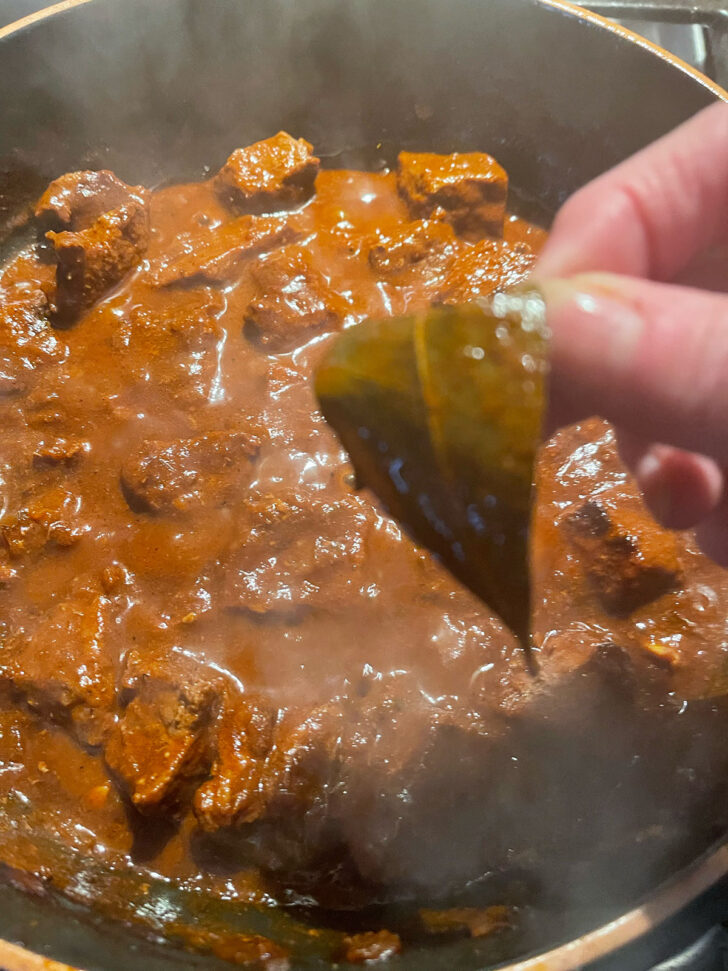
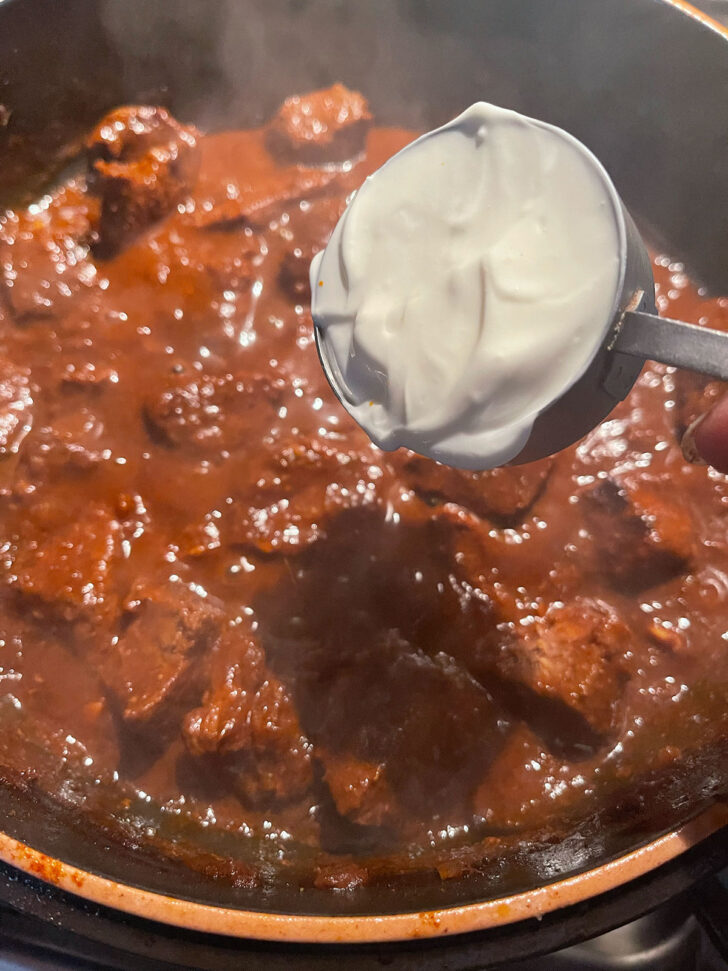
- Bring to a boil, then reduce heat, cover the pot and simmer for 45 minutes.
- After 45 minutes, remove the lid and continue to simmer until the sauce is thickened and the beef is tender. Remove and discard the bay leaf.
- Finish by stirring in the sour cream.
What to serve with Beef Paprikash
Beef Paprikash is delicious served over egg noodles or mashed potatoes. A nice green vegetable, such as broccoli or roasted carrots would be nice on the side.
Recipe tips!
- Some like to add the paprika when returning the beef to the pan, before adding the broth, to heat the spice a bit. You can do that, if you like, but beware that paprika can easily burn and introduce a bitter flavour to the dish, which is not a great way to start. I prefer to just add it later, to be safe.
- Although it does take more time, avoid crowding the beef in the pan when browning. Giving the pieces space ensures a nice brown colour and flavour develops, so be sure to do it in 2 or 3 batches, instead of all at once.
- I use just a bit of sour cream in the dish, as I like to serve a dollop of sour cream on top when serving. You can certainly add more to the pot, if you like it a bit more creamy.
- Avoid boiling the stew after adding the sour cream, to avoid it splitting.
- Seasoning at the end of cooking is always important. If the sauce tastes flat at all or you feel like it is missing something, it probably needs more salt!
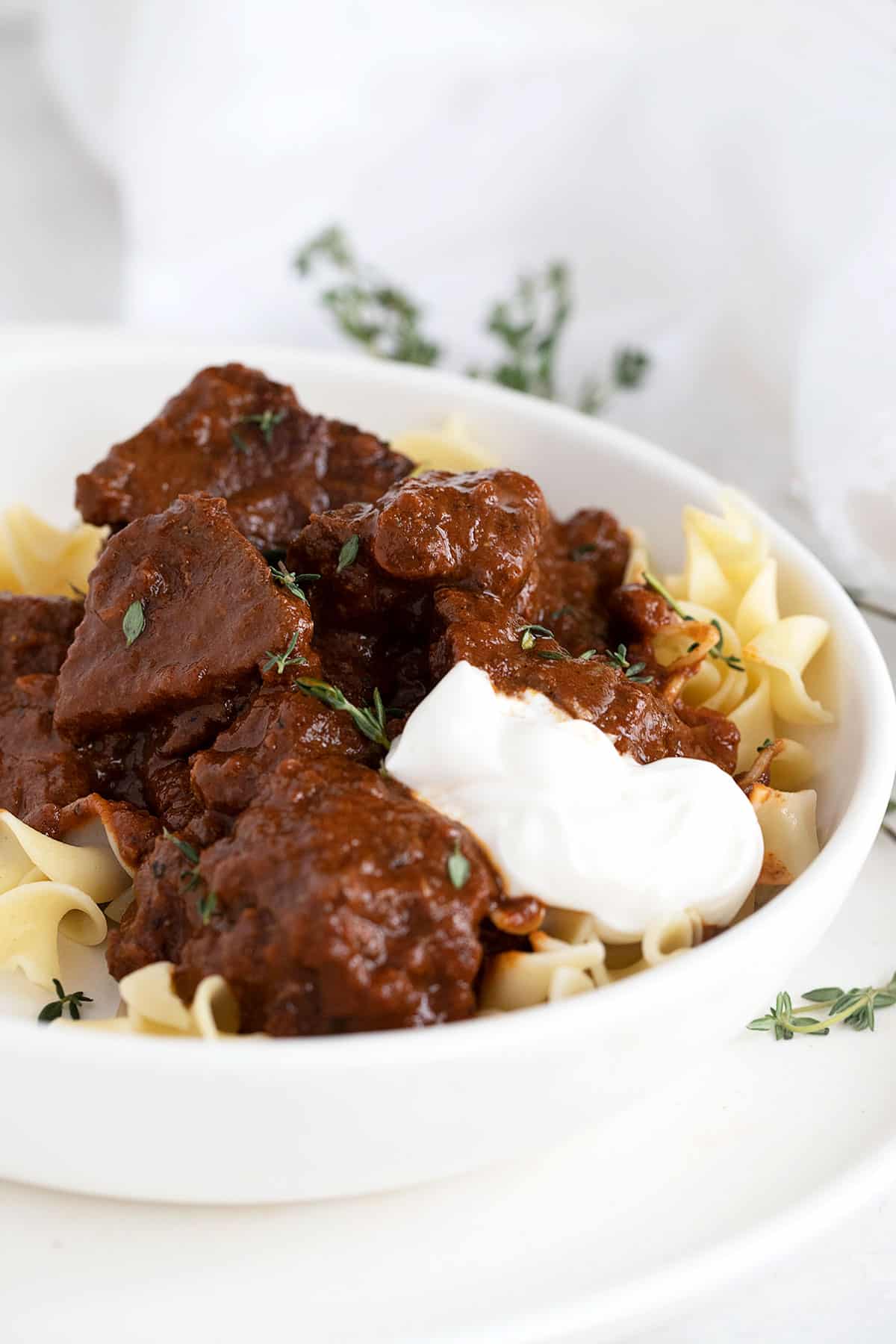
Making ahead, storing and freezing
Beef Paprikash can be made ahead and reheated. Like most stews, it almost gets better with sitting. Store in the fridge for up to 3 days or freeze up to 3 months.
Re-heat on the stove-top or in the microwave, covered. If it thickens up too much, just add a splash of beef broth to loosen the sauce.
Want to save this recipe?
Enter your email & I’ll send it to your inbox. Plus, get great new recipes from me every week!
By submitting this form, you consent to receive emails from Seasons and Suppers.
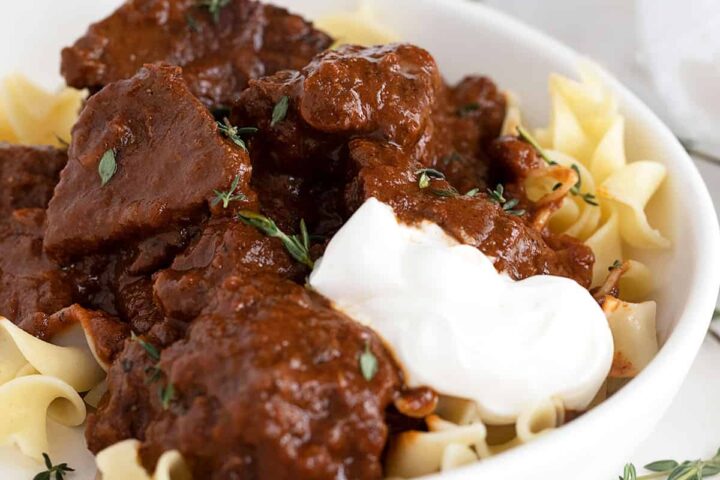
Get the Recipe: Hungarian Beef Paprikash
Ingredients
- 1 1/2 lb boneless beef roast, cut into 1-inch cubes or stewing beef cubes
- Salt and freshly ground pepper
- 1 Tablespoon vegetable oil, plus more, as needed
- 1 cup onion, diced
- 1/2 red bell pepper, diced, (optional)
- Pinch salt
- 1/4 cup red wine, to deglaze pan
- 2 – 3 Tablespoon sweet Hungarian paprika, to taste
- 1 teaspoon caraway seeds, (optional) crushed with a mortal and pestle
- 1/2 teaspoon dried marjoram, or 1/4 teaspoon oregano
- 1/2 teaspoon dried thyme leaves
- Pinch cayenne pepper, or hot paprika (optional)
- 3 cups beef broth, low-sodium, recommended
- 3 Tablespoons tomato paste
- 2 cloves garlic, crushed
- 1/2 teaspoon brown sugar, (optional)
- 1 bay leaf
To finish:
- Salt and freshly ground pepper, to taste
- 1/4 – 1/3 cup sour cream, at room temperature
Instructions
- Cut beef into 1-inch cubes and season with salt and pepper. Heat oil in a Dutch oven or large, heavy skillet (with a lid) over medium-high heat. Add the beef cubes in 2-3 batches, without over-crowding the pan, and cook until browned on all sides. Remove beef to a bowl. Add a bit more oil between batches and brown remaining beef.
- Reduce pan heat to medium. Add a bit more oil to the pan, if needed, then add the onion. Cook, stirring, until the onion is softened and starting to colour a bit. Add the wine (or an equal amount of water) and allow to cook until the wine has mostly disappeared, about 2 minutes.
- Return the beef to the pan, then add the spices, beef broth, tomato paste, garlic and brown sugar. Stir to combine. Bring to a boil. Add a bay leaf to the pot, reduce heat to medium-low, cover the pot with a lid and allow to simmer for 45 minutes.
- After 45 minutes, remove the lid, stir, then continue simmering for an additional 45-60 minutes, stirring occasionally, until the sauce has thickened and the beef is tender. Watch closely at the end of cooking (as the sauce thickens), so it doesn't reduce too much and scorch. Add a bit of water, if necessary.
- Remove and discard the bay leaf. Taste sauce and add additional salt and pepper, as needed. Finally, stir in the sour cream and heat just until warmed. Try not to boil the mixture after you have added the sour cream.
- Serve warm over egg noodles or mashed potatoes. Store left-overs in the fridge up to 3 days or freeze up to 3 months.
Notes
More Beef Recipes to Love!
Hi! I’m Jennifer, a home cook schooled by trial and error and almost 40 years of getting dinner on the table! I love to share my favourite recipes, both old and new, together with lots of tips and tricks to hopefully help make your home cooking enjoyable, stress free, rewarding and of course, delicious!


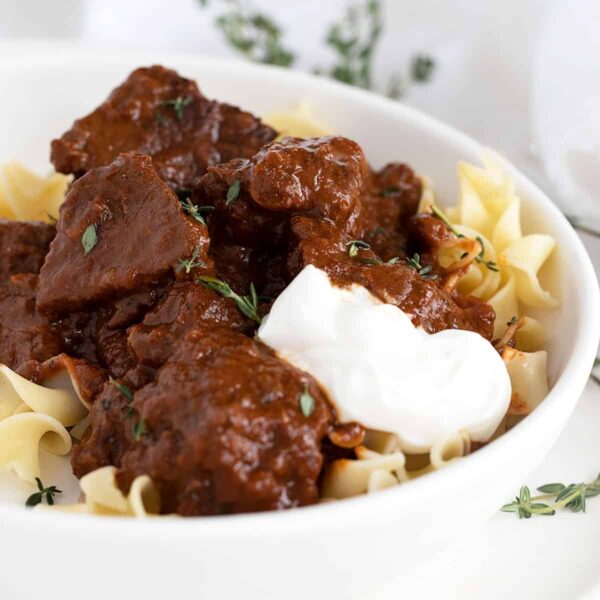
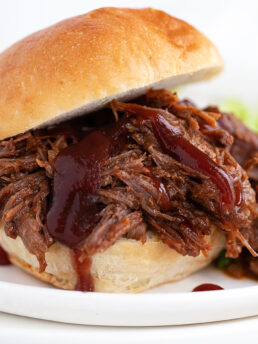
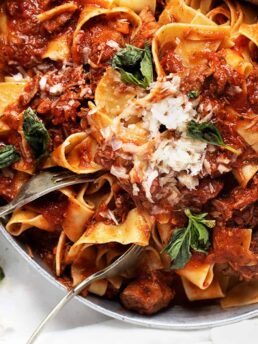
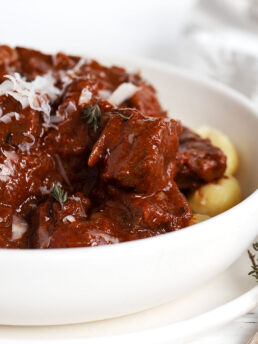

I made this for my family and it was excellent. I did omit the red pepper and caraway and added approx 1/2 cup of sour cream to the sauce and some sliced mushrooms and simmered for about 10 minutes at the end. It was very delicious and I will definitely add it to my ‘keeper’ recipe book.
Happy to hear, Kathy! Thanks so much :)
Fantastic flavour! Reminds me of eating at our favourite Hungarian restaurant in London, ON. Comes together quickly for a dinner party.
This was delicious! My teenage son went back for seconds and asked me to make it for him again a few days later.
So glad to hear, Jen :) It’s one of my favourite beef stews. Thanks so much!
I deglaze the pan with red wine vinegar and look cook down. Also I added one tablespoon of smoked paprika. Was very good. Will definitely be making again
So glad you enjoyed it, John :) Thanks so much!